I. What are the Steps of the Viral Life Cycle?
As we’ve mentioned in another article, what makes viruses so interesting to study and cover is their ability to infect and hijack cells as an obligate intracellular parasite and turn their own cellular machinery against them to persist in viral infection.
Though there are many different types of viruses and many instances where they’ve come to endanger the public health of the population, you’ll see in this article that they all share a generally conserved series of steps which enables their viral infection and spread.
It’s thanks to the pioneering and ongoing research of virologists that we can actually develop a wide variety of medicinal drugs targeting different points along the viral replication pathway as we’ll give an example later in the article. Let’s get into one of the most interesting topics in biology!
II. The Sequence of Viral Replication
Luckily, because the viral cycle is completed in a series of steps, it’s relatively easy to follow the flow and path of viral replication from start to finish!
A. Generalized Phage and Animal Virus Life Cycles
Though there are a few minor differences, as we’ll discuss later, both phage and animal viruses share these general steps: 1) entry, 2) transcription, translation, & genome replication, 3) assembly, and 4) release!
I. Entry
Before entry, the virus must first attach to the cell surface usually mediated by viral protein-receptor binding. For phages, the tail fibers are used to anchor the virus to the cell.
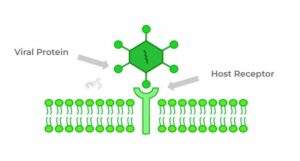
Depending on the virus there are 3 possible mechanisms for viral entry: membrane fusion, endocytosis, or genome insertion as shown below!
Note that for all the following cases shown, an animal virus was used as an example as bacteriophages only have one method of entry.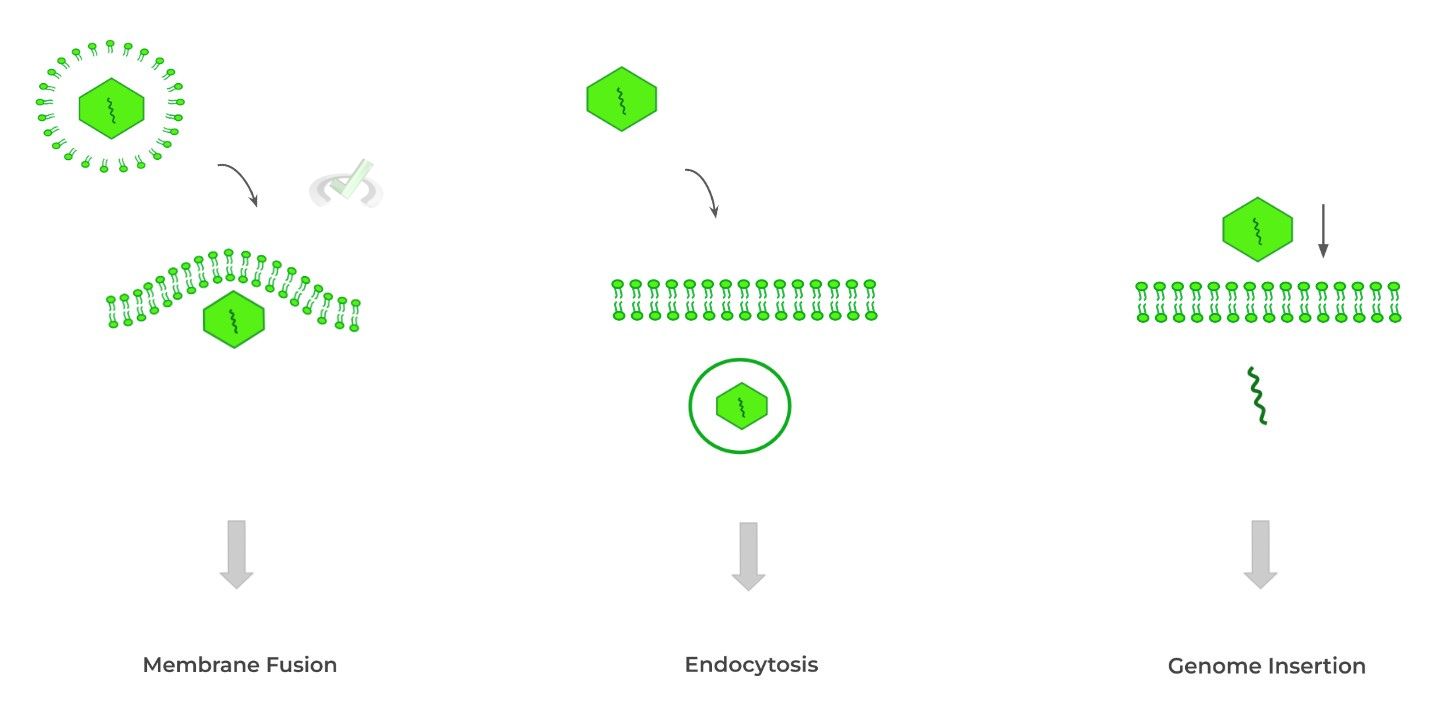
Note that an enveloped virus is needed for membrane fusion as the viral membrane will fuse with the host cell membrane! Endocytosis simply involves viral uptake via an endocytic vesicle.
Finally, some viruses will simply insert their genome into the host cell through pore formation. This is somewhat similar to how phages initiate infection!II. Transcription, Translation, and Genome Replication
After entry, transcription and translation first occur in order to generate all the necessary proteins for viral infection!
These include viral structural proteins, such as the capsid protein subunits, replication enzymes (if needed), and any other viral infection aiding proteins!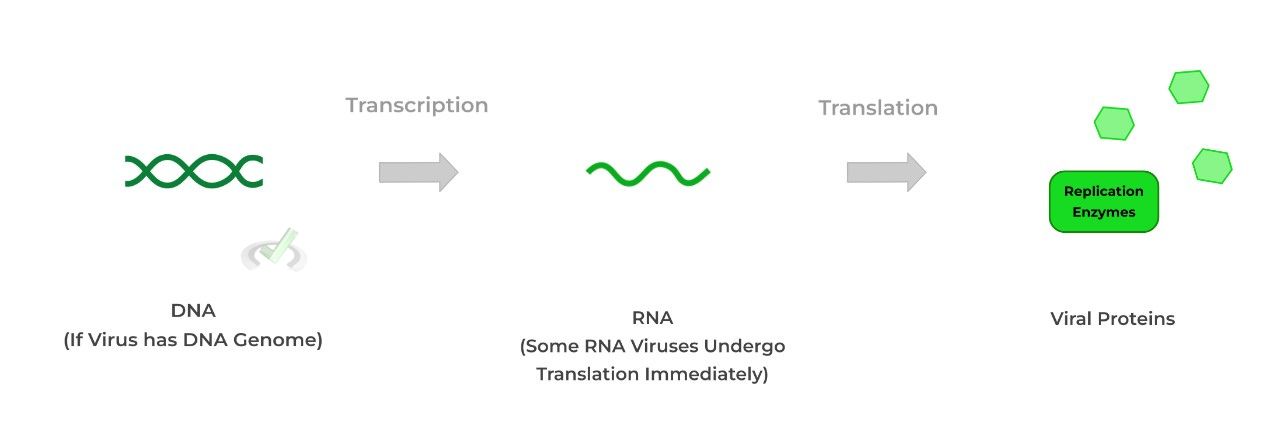
It’s usually after the translation of the replication machinery and structural viral proteins that genome replication ensues to be ready for assembly as discussed in the next step.
Note also that most of the time, DNA viruses won’t need to encode DNA polymerase because they’ll just utilize those found in the host!III. Assembly: Self Replicating Biological Units
After the viral structural proteins and genomes have been replicated, the viral components come together to form the complete viral particles, known as virions.
The simplicity and symmetry of viral structures allows for their self-assembly and replication into many virions!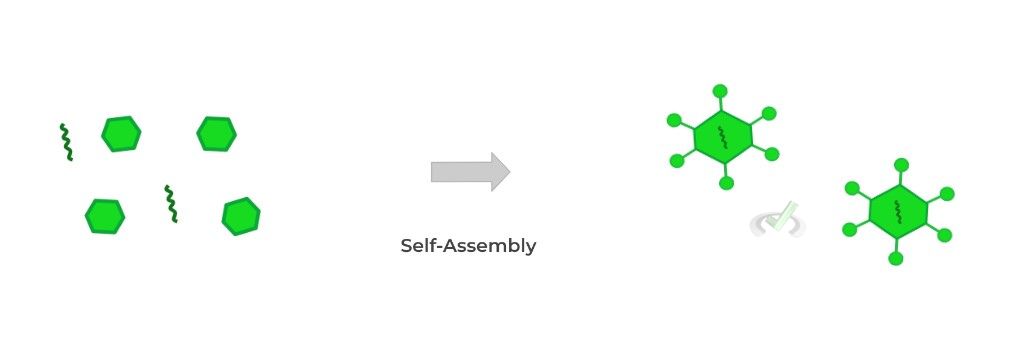
The repeating and symmetrical nature of the viral capsid subunit is actually by evolutionary design resulting in a viral structure that’s efficient and simple.
IV. Release
Finally, as all the virions become assembled and accumulate, they are released by cell lysis effectively killing the cell and moving onto subsequent infections.
Keep note that enveloped viruses need to bud out of the cell membrane to acquire their lipid membrane envelope, essentially the opposite of membrane fusion!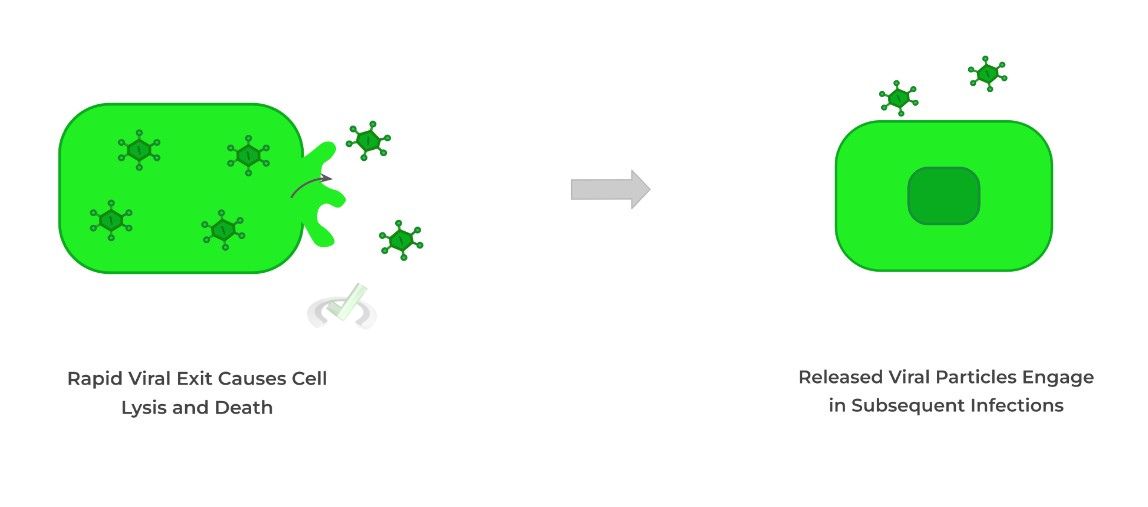
B. Unique Phage Viral Feature: Lytic v.s. Lysogenic Cycle
A unique feature to phage viral infection, but also seen in some animal viruses, is the ability to cycle between a lytic or lysogenic cycle.
The lytic cycle is characterized by ongoing virus replication and assembly eventually resulting in cell lysis when the virions are released.
In the lysogenic cycle, the genome of the phage can actually be integrated into the bacterial genome and exist in a noninfectious state, termed prophage.
An important aspect of this feature is the ability for a prophage in the lysogenic cycle to enter into the lytic cycle as indicated by the arrow above in the figure!
This is often due to an external stimulus such as UV radiation or the presence of reactive oxygen species!C. Case Study in Retroviruses: Life Cycle, Genome Integration into Host, and HIV
As we stated, there are some cases, though not as common, where animal viruses also enter into a dormant, lysogenic phase. Usually for animal viruses, we use the term “latency”.
To give an example, retroviruses are a type of animal virus that can integrate their genome into animal host cells.

The most unique feature of retroviruses is their use of reverse transcriptase, which utilizes the virus’ RNA genome as a template to synthesize complementary DNA (cDNA).
The cDNA can then be integrated into the host genome via the enzyme integrase and lie dormant until the appropriate stimuli occurs to initiate the lytic phase.
One of the most impactful retroviruses in terms of public health and pandemia is the HIV or human immunodeficiency virus, which targets the CD4+ T helper cells, weakening the immune system.III. Bridge/Overlap
As stated above, it’s been crucial to study the steps within the viral cycle in order to potentially develop therapeutics targeting and inhibiting different points along the viral life cycle. Let’s look at an example!
I. Antibody Therapy in Viral Infection
You’ve without a doubt heard this therapy within the last few years as this was only one of the tried and true ways of treating SARS-CoV-2 infection, with the underlying theory being relatively simple!
This method inhibits the first step of attachment and entry by introducing antibodies specific towards the viral protein antigen which binds to the ACE-2 receptor.
By blocking the viral protein: receptor interaction, viral entry is inhibited and thus overall infection is inhibited!
IV. Wrap Up/Key Terms
Let’s take this time to wrap up & concisely summarize what we covered above in the article!
A. Generalized Phage and Animal Virus Life Cycle
Though a few minor differences between them are present, both bacteriophages and animal viruses share the below mentioned steps in their viral life cycle. Enter your text here...
I. Entry
Attachment first to the cell is crucial and is often mediated via protein-receptor binding for animal viruses and tail fiber anchoring for phages.
After protein-receptor binding, animal viruses can enter the cell in one of the following ways: membrane fusion, endocytosis, or genome insertion.II. Transcription, Translation, and Genome Replication
Usually, transcription and translation first occur to generate all the necessary proteins for viral infection such as capsid structural proteins, replication enzymes, etc.
Genome replication then takes place which will then be ready for assembly as discussed in the next step.III. Assembly: Self-Replicating Biological Units
The replicated viral proteins and genomes can now come together to form the complete viral particles called virions.
Their structural and repetitive simplicity is a mark of evolutionary design, allowing the viral components to self-assemble!IV. Release
As all the virions come together and aggregate, they are released via cell lysis which kills the cells and moves onto subsequent infections.
B. Unique Phage Feature: Lytic v.s. Lysogenic Cycle
One unique feature to bacteriophages, though sometimes seen in animal viruses, is the ability to cycle between a lytic or lysogenic cycle.
The lytic cycle refers to active viral replication and cell lysis upon viral release while the lysogenic cycle refers to when the viral DNA integrates into the host genome., termed “prophage”.
Given the right external conditions, such as UV radiation, lysogenic prophages can be activated to enter into the lytic phase!C. Case Study in Retroviruses: Life Cycle, Genome Integration into Host, and HIV
Retroviruses are one example of where an animal virus can enter into a lysogenic cycle, usually termed “latency”.
Their most unique feature is the utilization of reverse transcriptase which generates cDNA from the RNA genome template. The cDNA can then be incorporated into the genome via integrase.
One of the most well studied and impactful retroviruses is HIV (human immunodeficiency virus), which targets the CD4+ T helper cells, weakening the immune system.V. Practice
Take a look at these practice questions to see and solidify your understanding!
Sample Practice Question 1:
Which part of the central dogma of molecular biology is broken/reversed during the viral life cycle of retroviruses?
A. Transcription
B. Translation
C. Replication
D. Degradation
Ans. A
Note the replication and degradation are not part of the central dogma. Because DNA is synthesized from a RNA genome, the process of transcription is reversed/backwards.
Sample Practice Question 2:
How can you best describe the product molecule that results from reverse transcriptase action?
A. The molecule is single stranded and contains thymine bases
B. The molecule is single stranded and contains uracil bases
C. The molecule is double stranded and contains thymine bases
D. The molecule is double stranded and contains uracil bases
Ans. C
Recall that the function of reverse transcriptase is to produce cDNA (double stranded) from the virus’ RNA genome (single stranded). As such, any uracil bases should be replaced with thymine bases.







 To help you achieve your goal MCAT score, we take turns hosting these
To help you achieve your goal MCAT score, we take turns hosting these 





















 reviews on TrustPilot
reviews on TrustPilot